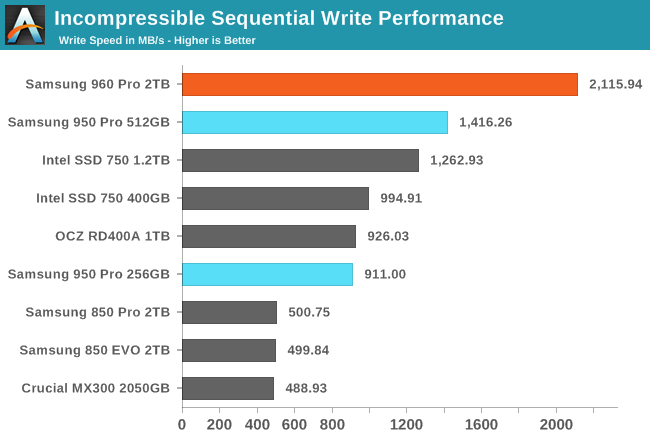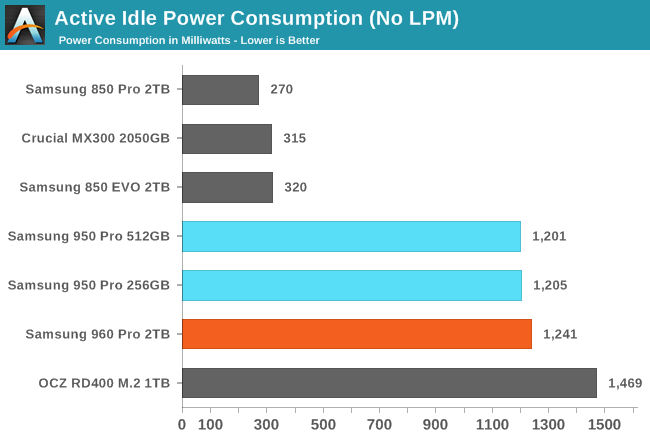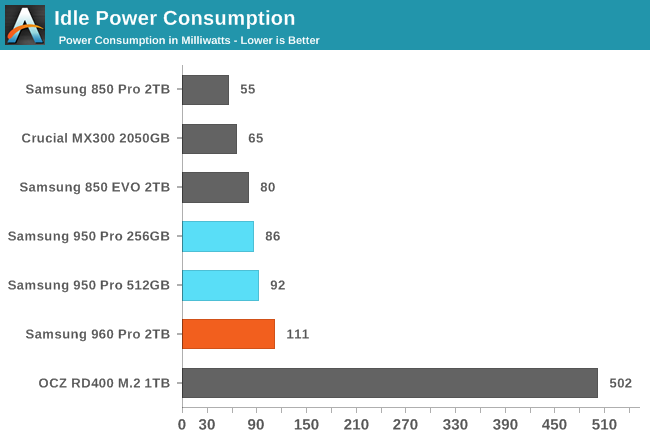The Samsung 960 Pro (2TB) SSD Review
by Billy Tallis on October 18, 2016 10:00 AM ESTATTO
ATTO's Disk Benchmark is a quick and easy freeware tool to measure drive performance across various transfer sizes.
 |
|||||||||
The 960 Pro hits full performance at 32kB or larger transfers, while the Intel SSD 750 doesn't reach its highest read speeds until 1MB transfers and the OCZ RD400 needs 512kB transfers for its highest read speeds. Unlike the 512GB 950 Pro, the 960 Pro does not hit any severe thermal throttling.
AS-SSD
AS-SSD is another quick and free benchmark tool. It uses incompressible data for all of its tests, making it an easy way to keep an eye on which drives are relying on transparent data compression. The short duration of the test makes it a decent indicator of peak drive performance.


The 960 Pro's read speed breaks away from the pack of other PCIe SSDs but still doesn't come close to the advertised 3.5GB/s. The write speed stands out even more and very slightly exceeds the advertised speed of 2100MB/s.
Idle Power Consumption
Since the ATSB tests based on real-world usage cut idle times short to 25ms, their power consumption scores paint an inaccurate picture of the relative suitability of drives for mobile use. During real-world client use, a solid state drive will spend far more time idle than actively processing commands.
There are two main ways that a NVMe SSD can save power when idle. The first is through suspending the PCIe link through the Active State Power Management (ASPM) mechanism, analogous to the SATA Link Power Management mechanism. Both define two power saving modes: an intermediate power saving mode with strict wake-up latency requirements (eg. 10µs for SATA "Partial" state) and a deeper state with looser wake-up requirements (eg. 10ms for SATA "Slumber" state). SATA Link Power Management is supported by almost all SSDs and host systems, though it is commonly off by default for desktops. PCIe ASPM support on the other hand is a minefield and it is common to encounter devices that do not implement it or implement it incorrectly. Forcing PCIe ASPM on for a system that defaults to disabling it may lead to the system locking up; this is the case for our current SSD testbed and thus we are unable to measure the effect of PCIe ASPM on SSD idle power.
The NVMe standard also defines a drive power management mechanism that is separate from PCIe link power management. The SSD can define up to 32 different power states and inform the host of the time taken to enter and exit these states. Some of these power states can be operational states where the drive continues to perform I/O with a restricted power budget, while others are non-operational idle states. The host system can either directly set these power states, or it can declare rules for which power states the drive may autonomously transition to after being idle for different lengths of time.
The big caveat to NVMe power management is that while I am able to manually set power states under Linux using low-level tools, I have not yet seen any OS or NVMe driver automatically engage this power saving. Work is underway to add Autonomous Power State Transition (APST) support to the Linux NVMe driver, and it may be possible to configure Windows to use this capability with some SSDs and NVMe drivers. NVMe power management including APST fortunately does not depend on motherboard support the way PCIe ASPM does, so it should eventually reach the same widespread availability that SATA Link Power Management enjoys.
We report two idle power values for each drive: an active idle measurement taken with none of the above power management states engaged, and an idle power measurement with either SATA LPM Slumber state or the lowest-power NVMe non-operational power state, if supported.

The active idle power consumption of the PCIe SSDs is still far higher than is typical for SATA SSDs, and is enough to keep their temperatures relatively high as well. The 960 Pro 2TB draws only slightly more power than the 950 Pro.

With power saving modes enabled, the Samsung NVMe SSDs are almost as efficient as typical SATA SSD, with the 960 Pro unsurprisingly drawing a little more power than the lower-capacity 950 Pros. The OCZ RD400 does benefit some from power management, but still draws far more than it should.










72 Comments
View All Comments
Billy Tallis - Tuesday, October 18, 2016 - link
The Intel 600p is very high on my to-do list. Since it's also using the Microsoft NVMe driver I want to run it through some more tests before publishing the review, but it should be done before I get the 960 EVO.WatcherCK - Tuesday, October 18, 2016 - link
Curious about the operating temperatures of the drive, Im guessing that Destroyer gave it a good thermal workout :) Puget Systems have done some testing on the effect of adding cooling to M2 SSDs:https://www.pugetsystems.com/labs/articles/Samsung...
Aquacomputer also make a PCIe Riser card equipped waterblock for M2 drives for those who want to water cool their SSD, the kryoM.2
Does anyone know if moving an M2 drive to a riser card improves cooling for the drive? I would think there is a little bit of improvement bringing the drive off the surface of the motherboard... How if at all is everyone keeping their motherboard mounted SSDs cool?
BurntMyBacon - Wednesday, October 19, 2016 - link
@WatcherCKYes, moving an M.2 drive to a riser card improves cooling (at least in my system). I checked temperatures mounted on my motherboard with a spot cooler directly on the 950Pro. I then compared it against mounting on a Silverstone ECM20 and an Asus Hyper M.2 X4 Mini (no spot cooler). If you are able to direct good airflow to the riser card, as I was, the Asus riser card is significantly cooler even though it had no spot cooler. If you use a thermal pad on the back of the M.2 drive on the Silverstone EMC20, it may in fact do even better than the Asus, but it my system, the larger standoffs allowed more air to flow behind the M.2 drive on the Asus solution. In any case, I can't seem to induce thermal throttling on my 950Pro in my setup regardless of how hard I try. Again, it will depend on how much airflow you can deliver it.
Gradius2 - Tuesday, October 18, 2016 - link
Those SSDs suffering from HEAT. If you don't put a forced cooling on them, it will DEGRADE the speed no matter what! This is why you won't see much than 3GB/s !iwod - Wednesday, October 19, 2016 - link
Where are these performance heading. Where Do we need to go. The destroyers and heavy definitely dont represent 95% of the consumer users usage. Do we need more higher Random Q1 Read Write? Or do we need higher Seq Read Write? If so then we dont need our firmware and powerful CPU core for QD32. Will that save cost? Why are we still within the 5W power usage? When can we get those dropped down to 2W or less.zodiacfml - Wednesday, October 19, 2016 - link
blazing fast. i will not be able to make useod this speed except for W10 upgradesprofdre - Monday, October 24, 2016 - link
@ Billy Talis: Would it be possible to test on another mainboard? There seems to be a clear bandwidth issue for sequential transfers, as other tech sites as https://www.computerbase.de/2016-10/samsung-ssd-96... achieved almost 3400 MB/s in CrystalDiskMark for the 512 GB model. At first they struggled to reach more than 3100 MB/s. (Samsung values were achieved with CrystalDiskMark according to computerbase).calbear88 - Tuesday, November 15, 2016 - link
Great table in the article summarizing the different Samsung NAND technologies. Here's a summary of the different types of NAND and which products they were in.27nm MLC 830 PM830
21nm MLC 840 pro
21nm TLC 840
19nm MLC XP941
19nm TLC 840 Evo
16nm MLC SM951
16nm TLC 750 Evo PM951
32 layer 86bit v-NAND MLC 850 Pro
32 layer 128bit v-NAND TLC 850 Evo
32 layer 128bit v-NAND MLC 950 Pro
48 layer 128bit v-NAND MLC 960 Pro SM961
48 layer 128bit v-NAND TLC 960 Evo PM961
Meteor2 - Wednesday, November 23, 2016 - link
How is new dies and an entirely new controller 'just a generational refresh of the 950 Pro', from any angle?anaconda1 - Monday, February 13, 2017 - link
The Samsung 2.1 driver has DPC latency issues on my end. I am usign a Samsung 960 500GB Evo nvme and using it with the Native Microsoft Driver (Windows 10 with latest updates installed) or the Samsung 2.0 driver, all is ok, DPC latency reports are fine - Latencymon and latency checker both report trouble free operation. However, installing the 2.1 driver, both Latencymon and dpc latency checker report problems with storport.sys and problems with DPC. Rolling back the driver from the Samsung 2.1 to the Microsoft or the Samsung 2.0, all goes back to normal